Evaluation of GHG Emission Measures Based on Shipping and Shipbuilding Market Forecasting
Abstract
1. Introduction
1.1. Background and Research Objective
1.2. Related Literature
- The long-term impact of current GHG reduction measures, such as the deceleration of operations of ships, transition to LNG fuel, and promotion of the energy efficiency design index (EEDI), is evaluated.
- GHG emission reduction countermeasures based on the introduction of zero-emission ships, which are being considered for introduction in the future, are considered.
- The GHG emission reduction effect by current measures and future measures alone is clarified using the proposed model. Additionally, the impact and effectiveness of combining current measures and future measures are evaluated using the proposed model.
- The limitations of operating speed deceleration measures on shipping and the shipbuilding market are evaluated quantitatively using the proposed model.
2. Basic Concept
2.1. Overview of System Dynamics
2.2. Basic Configuration of the SD Model
- Cargo transportation prediction model: This model forecasts the total volume of sea cargo movement based on world gross domestic product (GDP) and cargo transportation distance.
- Order prediction model: This model forecasts the number of orders based on sea cargo movement, fleet volume, backlog of shipyard, and ship price. It considers the change in the number of newly built ships due to ship operating speed reduction.
- Construction model: Ship construction period is influenced by construction capacity and shipyard order book. The model estimates the total number of ships constructed.
- Ship price prediction model: This model forecasts the price of a newly built ship based on the backlog of shipyards.
- Scrap model: This model predicts the number of scrapped ships each month based on the ship’s age and shipping market condition. It considers the change in the amount of scrapped ships due to ship operating speed reduction.
- GHG emissions prediction model: This model forecasts GHG emissions based on the number of ships and fuel consumption. It considers differences in engine performance by ship’s age and size. Fuel consumption of auxiliary engine and boiler and differences in fuel type are also considered.
- The total volume of sea cargo movement is calculated by inputting world GDP and cargo transportation distance using (1) the cargo transportation prediction model.
- The ship running distance, which is a measure of transportation efficiency of shipping, is calculated based on sea cargo movement and fleet volume. After that, ship orders and scrapped ships are calculated using (2) the order prediction model and (5) the scrap model.
- The number of orders is determined, the orders for new ships are added to the order books in shipyards, and the amount of ship construction and ship price are calculated considering shipyard condition using (3) the construction model and (4) the ship price prediction model.
- In (6) the GHG emissions prediction model, the fuel consumption for each ship is estimated considering operating speed, ship performance, ship composition, and technological developments for GHG reduction. GHG emissions are calculated based on fuel consumption and fleet volume. Moreover, the operating speed influences the transport efficiency of each ship, and hence also the ship running distance. Shipping and shipbuilding market conditions are changed by this influence.
- Fleet volume and ship composition are updated based on the amounts of ship construction and scrap.
3. GHG Emissions Prediction Model
3.1. Overview of GHG Emissions Prediction Model
- Ship speed deceleration affects shipping and shipbuilding markets. Ship operating speed deceleration influences on shipping and shipbuilding markets and GHG emissions reduction is considered in this study.
- The fuel efficiency performance of ships differs depending on the year of their construction, due to technological developments and regulation changes. The time-series change in fuel efficiency performance of ships is considered in this study.
3.2. Data Utilized in GHG Emissions Prediction Model Development
- (1)
- Ship composition: Ship composition shows the fleet volume for ships at all ages. The ship composition of Capesize, Panamax, Handymax, and Handysize from 2013 to 2018 was obtained from Sea-web ships [24]. It should be noted that Sea-web ships is a ships database provided by IHS Markit.
- (2)
- Ship performance: Ship performance varies depending on the size of the ship. The performance items in this study are shown below.
- (i)
- Main engine power: The main engine power is the value of the main engine mounted on the ship.
- (ii)
- Service speed: The service speed is the average ship speed by a ship under loading condition and in calm weather.
- (iii)
- (iv)
- Fuel consumption of auxiliary equipment and boilers: Fuel consumption of auxiliary equipment and boilers also impacts GHG emission. Fuel consumption by these ship elements is considered. The values are set based on the fourth IMO GHG study [4].
- (3)
- Average voyage time: Average voyage time is determined by converting the annual average voyage days into monthly average hours.
- (4)
- Average DWT: When calculating CO2 emissions, average DWT is required as a representative value for each ship size, as the unit of fleet volume is converted from the DWT to the number of ships. Average DWT was determined using the actual number of ships and the total DWT of the fleet volume.
- (5)
- Calibration factor, CO2 emission correction coefficient: CO2 emissions estimation results for each ship size have been reported in previous studies [4]. The calibration factor was introduced to reproduce the reported CO2 emissions, because ship size classification and the representative value for each ship size are different between this study and previous studies. This calibration factor was determined using the estimated CO2 values and actual ship composition data. Additionally, it is also necessary to consider ships whose size is below Handysize (less than 10,000 DWT) when calculating the CO2 emissions of a bulk carrier. Therefore, we introduced the CO2 emission correction coefficient to consider the CO2 emissions of smaller ships. The CO2 emission correction coefficient has an average value of 1.02, calculated from the actual value for ships smaller than and over 10,000 DWT.
- (6)
- Scrap ship list: The scrap rate for each size is defined to update the ship composition, which is used when calculating CO2 emissions. The scrap ship list was used to define the scrap rate.
3.3. Model Development for GHG Emissions Prediction Model
- (1)
- Calculate main engine output by ship size using Equation (1). The difference in engine output depending on the ship’s size is considered; in addition, we consider the effect of deceleration operating on the ratio of service speed to operating speed. Instantaneous main engine power (Pme) changes depending on the cube of the ratio of operating speed (Vt) to service speed (Vref).
- (2)
- Calculate monthly CO2 emissions using equation (2). First, fuel consumption is calculated by multiplying the main engine output calculated by SFC, which represents fuel consumption per hour of engine output, and voyage time. As shown in Table 3, SFC is determined by the size and age of the ships. In addition, fuel consumption of auxiliary equipment and boiler for each ship size is considered constant, as noted. For CO2 emissions below Handysize (0–9999 DWT), the effect is considered by multiplying the total value of CO2 emissions for each size by the correction coefficient γ. It should be noted that the percentage of total CO2 emissions taken up by auxiliary equipment and boiler is approximately 10.8% in the case that operating speed is 85.0% of service speed.where Pme is instantaneous main engine power (kW), Pref is main engine power (kW), Vref is service speed (knots), Vt is operating speed (knots), α is the calibration factor, CO2 is CO2 emission (g), SFC is fuel consumption per kWh (gfuel/kWh), Cf is carbon content in fuel (gCO2/gfuel), time is average voyage time (hours), N is the number of ships (number), Ax is auxiliary equipment fuel consumption (g), Bo is boiler fuel consumption (g), γ is the CO2 emission correction coefficient, i is ship size (1: Capesize, 2: Panamax, 3: Handymax, 4: Handysize), a is the age of ships, ε is the fuel type (1: HFO, 2: LNG fuel, 3: zero-emission fuels), and t is simulation time (months).
3.4. Correction of Order Prediction Model
- In an ordinary situation, orders will gradually increase as the ship running distance increases (Figure 2(a).
- In a condition where the ship running distance is large, when the ship running distance reaches a certain level, the operation of the ship reaches its limit, and orders increase rapidly (Figure 2(b)).
3.5. Update of Ship Composition
- (1)
- Use the scrap model to calculate the amount of scrap. The scrap model was defined for each size (Figure 4). An overview of the scrap model and the model development procedures is given in a previous study (Wada et al. [17]). However, we modified the scrap model by considering the operating speed rate, using the same concept as in Figure 3.
- (2)
- Use the scrap rate according to ship age to calculate the scrap ship by ship age. The scrap rate was defined by normalizing the actual value of demolition (Figure 5). The scrap ship list until 2018 was utilized to define the models. Ship composition was updated by deducting each age of scrap ships. After that, ship composition was updated for 1 month.
- (3)
- Use the construction model to calculate the amount of constructed ships. The amount of constructed ships is added to 0 years of age for each size of ship composition.
4. Model Validation
- Input scenarios: January 2013 to December 2018
- (1)
- World GDP: (actual data)
- (2)
- Cargo transportation distance: (actual data)
- (3)
- Operating speed (actual data)
- Initial values: January 2013
- (1)
- Fleet volume: 6.80 × 108 (DWT)
- (2)
- Order books: 1.40 × 108 (DWT)
- (3)
- Construction capacity: 9.85 × 106 (DWT)
- (4)
- Ship amount under construction: 5.10 × 107 (DWT).
5. Case Study
5.1. Impact Assessment of Current Measures
5.1.1. Overview of Current Measures
- (1)
- Deceleration operation: This measure can suppress GHG emissions by reducing the main engine’s output to save fuel during voyages. The average operating speed for ships has reduced since 2008.
- (2)
- Transition to LNG fuel: LNG, which has the effect of reducing fuel consumption and the carbon content rate, is drawing attention as an alternative to heavy fuel oil (HFO). The carbon content rate (Cf in Equation (2)) is 3.114 (gCO2/gfuel) in HFO and 2.750 (gCO2/gfuel) in LNG. SFC in Equation (2) is 156 g/kWh in LNG. In HFO, SFC in Equation (2) is utilized in Table 3. These values are from the fourth IMO GHG study [4]. Carbon content rate (Cf) and SFC were lower in LNG fuel than in HFO fuel.
- (3)
- Technological development to achieve EEDI regulation: EEDI is the amount of CO2 emissions when carrying 1 ton of cargo for 1 mile. By restricting this value, the fuel efficiency of ships is promoted and CO2 emissions are reduced. As the percentage of ships in the fleet volume that has passed regulation value increases with each passing year, it is necessary to take a long-term perspective on impact assessment of the EEDI regulation. In this study, we assumed that the EEDI regulation will be achieved by technology development, such as reduction of hull resistance and improvement of propeller efficiency in HFO ships.
5.1.2. Scenario Settings
- (1)
- World GDP: Actual values for 2013–2019 were used and 3.5% GDP growth from 2020 was assumed. This assumption was based on the average GDP growth rate from 1980 to 2019, obtained from the International Monetary Fund [26].
- (2)
- Cargo transportation distance: Actual values for 2013–2019 were used, and after 2020, the values were assumed to be constant.
- (3)
- Operating speed reduction: It is still unclear how much ships will slow down in the future shipping industry. In this study, the actual value was used for 2013–2019, and after 2020, it was assumed that the speed is linearly reduced until 2050, reaching the intensity of deceleration that achieves 40% deceleration in 2050. The influence of operating speed reduction on GHG emissions and the implication for the maritime market industry are discussed in Section 5.4.
- (4)
- Transition to LNG fuel: The balance of construction for HFO- versus LNG-fueled ships is shown in Table 5. We assumed that the ratio of LNG-fueled ships to total construction is set at 50% in 2020–2029, 60% in 2030–2039, and 70% in 2040–2050. In actuality, the order books of LNG-fueled ships among all type of ships for 2020 were approximately 12.2% based on the Clarkson database [23], and HFO ships are still the main ordered ships. This scenario is different from actual trends.
- (5)
- Technological development to achieve EEDI regulation: We impose a 10% reduction of CO2 emission efficiency in ships built after 2015, a 20% reduction in ships built after 2020, and 30% reduction in ships built after 2025 as compared with the 2013 EEDI regulation level. This scenario was based on the IMO resolution [27]. Table 6 shows the impact of SFC on EEDI efficiency improvement. The effects of EEDI efficiency improvement on SFC parameters of the main engine are estimated in the third IMO GHG study [1], and we used this table in this study.
- Business as usual (BAU) lines: The base year for CO2 emissions is set as 2008 based on the initial IMO strategy for reduction of GHG emissions from ships [22]. The BAU lines indicate that some GHG reduction measures have not been applied since 2008. The BAU lines are calculated using the model proposed in this study.
- Mid-term goal: In the initial strategy for reducing GHG emissions [22], the goal of halving GHG emissions by 2050 was decided based on 2008. Based on this strategy, a mid-term goal of 50% reduction of CO2 emissions of bulk carriers by 2050 as compared with 2008 was set. CO2 emissions of bulk carriers in 2008 were 194.0 × 106 tons based on the third IMO GHG study [1]. Therefore, the mid-term goal is set at 97.0 × 106 tons in this study. It should be noted that CO2 emissions of bulk carriers were 193.4 × 106 tons in 2018. Comparing the CO2 emissions in 2018 and 2008, no significant change was found.
5.1.3. Simulation Results for Current Measures
5.2. Impact Assessment of Future Measures
5.2.1. Scenario Settings
- Introduction of zero-emission ships: Zero-emission ships use hydrogen (H2) fuel, ammonia (NH3) fuel, or other alternatives. By using these fuels, GHG emissions from shipping become zero and significant reductions of GHG emissions are realized compared with current measures.
5.2.2. Evaluation Results with Future Measures
5.3. Impact Assessment of Combination of Current and Future Measures
5.3.1. Scenario Settings
- Technological development to achieve EEDI regulation is applied to HFO and LNG-fueled ships.
- Reduction in operating speed applies to HFO and LNG-fueled ships; zero-emission ships are not the target of operating speed reduction, which thus does not occur for them. This is because zero-emission ships are more efficient with regards to CO2 emissions compared with HFO and LNG-fueled ships. Additionally, LNG-fueled ships are more efficient in terms of CO2 emissions than HFO fuel ships. Therefore, the speed of LNG-fueled ships is 10% faster than that of HFO ships. This assumption is based on the concepts of energy efficiency existing ship index (EEXI) regulation [28].
5.3.2. Evaluation Results for Combination of Current and Future Measures
5.4. Limitation of Operating Speed Reduction
5.5. Discussion
6. Conclusions
- To estimate GHG emissions, a GHG emissions prediction model was developed and the scrap model was improved. Additionally, the GHG emissions prediction model was integrated into shipping and shipbuilding market models, and a model to consider GHG reduction measures was developed.
- To confirm the validity of the evaluation model for GHG reduction measures, simulations from 2013 to 2018 were conducted. The model validity was confirmed quantitatively.
- The GHG emission reduction effect by current measures and future measures alone was evaluated. Additionally, the impact and effectiveness of combining current measures and future measures were evaluated.
- The comprehensive scenarios to achieve IMO GHG emission goals were discussed considering current and future GHG reduction measures. From this simulation result, it was found that, in order to achieve the target of 2050, it is necessary to develop a zero-emission ship in addition to the current measures.
- We focused on the deceleration of operating speed, the influence of which on shipping and shipbuilding markets was evaluated. Concretely, the limitation of deceleration was considered from the maritime market perspective. This simulation result suggests that the limitation of ship operating speed reduction is approximately 50% from the maritime market perspective.
Author Contributions
Funding
Data Availability Statement
Conflicts of Interest
References
- Smith, T.W.P.; Jalkanen, J.P.; Anderson, B.A.; Corbett, J.J.; Faber, J.; Hanayama, S.; O’Keeffe, E.; Parker, S.; Johansson, L.; Aldous, L.; et al. Third IMO Greenhouse Gas Study 2014; International Maritime Organization: London, UK, 2015. [Google Scholar]
- Komiyama, R.; Suzuki, K.; Nagatomi, Y.; Matsuo, Y.; Suehiro, S. Analysis of Japan’s energy demand and supply to 2050 through integrated energy-economic model. J. Jpn. Soc. Energy Resour. 2012, 33, 34–43. (In Japanese) [Google Scholar]
- Holz, C.; Siegel, L.; Johnston, E.; Jones, A.; Sterman, J. Ratcheting ambition to limit warming to 1.5 °C: Trade-offs between emission reductions and carbon dioxide removal. Environ. Res. Lett. 2018, 13, 064028. [Google Scholar] [CrossRef]
- IMO: Fourth IMO GHG Study 2020, IMO MEPC 75/7/15. 2020. Available online: https://docs.imo.org/ (accessed on 6 August 2020).
- Faber, J.; Markowska, A.; Eyring, V.; Cionni, I.; Selstad, E. A Global Maritime Emissions Trading System—Design and Impacts on the Shipping Sector, Countries and Regions; CE Delft: Delft, The Netherlands, 2010. [Google Scholar]
- Lindstad, E.; Rialland, A. LNG and cruise ships, an easy way to fulfil regulations—versus the need for reducing GHG emissions. Sustainability 2020, 12, 2080. [Google Scholar] [CrossRef]
- Rehmatulla, N.; Calleya, J.; Smith, T. The implementation of technical energy efficiency and CO2 emission reduction measures in shipping. Ocean Eng. 2017, 139, 184–197. [Google Scholar] [CrossRef]
- Kobayashi, M.; Hashiguchi, Y.; Sawada, N. Actual status of slow-down operation: Challenges, countermeasures, and results of slow-down operation. J. Jpn. Inst. Mar. Eng. 2014, 49, 74–80. (In Japanese) [Google Scholar] [CrossRef][Green Version]
- Smith, T.W.P. Technical energy efficiency, its interaction with optimal operating speeds and the implications for the management of shipping’s carbon emissions. Carbon Manag. 2012, 3, 589–600. [Google Scholar] [CrossRef]
- Nielsen, K.S.; Kristensen, N.E.; Bastiansen, E.; Skytte, P. Forecasting the market for ships. Long Range Plan. 1982, 15, 70–75. [Google Scholar] [CrossRef]
- Sakalayen, Q.M.H.; Duru, O.; Hirata, E. An econophysics approach to forecast bulk shipbuilding orderbook: an application of Newton’s law of gravitation. Marit. Bus. Rev. 2020. [Google Scholar] [CrossRef]
- Gourdon, K. An Analysis of Market-Distorting Factors in Shipbuilding: The Role of Government interventions, OECD Science, Technology and Industry Policy Papers; OECD Publishing: Paris, France, 2019; Volume 67. [Google Scholar]
- Shin, J.; Lim, Y.-M. An empirical model of changing global competition in the shipbuilding industry. Marit. Policy Manag. 2014, 41, 515–527. [Google Scholar] [CrossRef]
- Taylor, A.J. The dynamics of supply and demand in shipping. Dynamica 1975, 2, 62–71. [Google Scholar]
- Japan Maritime Research Institute SD Study Group. SD model of maritime transportation and shipbuilding. Jpn. Marit. Res. Inst. Bull. 1978, 142. (In Japanese) [Google Scholar]
- Engelen, S.; Meersman, H.; Eddy, V.D.V. Using system dynamics in maritime economics: An endogenous decision model for ship owners in the dry bulk sector. Marit. Policy Manag. 2006, 33, 141–158. [Google Scholar] [CrossRef]
- Wada, Y.; Hamada, K.; Hirata, N.; Seki, K.; Yamada, S. A system dynamics model for shipbuilding demand forecasting. J. Mar. Sci. Technol. 2018, 23, 236–252. [Google Scholar] [CrossRef]
- Forrester, J.W. Industrial Dynamics; MIT Press: Cambridge, MA, USA, 1961. [Google Scholar]
- Sterman, J. Business Dynamics: Systems Thinking and Modeling for a Complex World; Irwin Professional Publishing: Burr Ridge, IL, USA, 2000. [Google Scholar]
- Sterman, J.; Fiddaman, T.; Franck, T.R.; Jones, A.; McCauley, S.; Rice, P.; Sawin, E.; Siegel, L. Climate interactive: The C-ROADS climate policy model. Syst. Dyn. Rev. 2012, 28, 295–305. [Google Scholar] [CrossRef]
- Wada, Y.; Hamada, K.; Hirata, N. A Study on the Improvement and Application of System Dynamics Model for Demand Forecasting of Ships. In Proceedings of the International Conference on Computer Applications in Shipbuilding, 1, Singapore, 26–28 September 2017; pp. 51–60. [Google Scholar]
- IMO MEPC72. Resolution MEPC.304(72). Initial IMO Strategy on Reduction of GHG Emissions from Ships. 2018. Available online: https://wwwcdn.imo.org/localresources/en/KnowledgeCentre/IndexofIMOResolutions/MEPCDocuments/MEPC.304(72).pdf (accessed on 21 January 2021).
- Clarksons Shipping Intelligence Network. Available online: http://www.clarksons.net (accessed on 6 February 2021).
- Sea-Web Ships. Available online: https://maritime.ihs.com/Account2/Index (accessed on 8 December 2019).
- Buhaug, Ø.; Corbett, J.J.; Endresen, Ø.; Eyring, V.; Faber, J.; Hanayama, S.; Lee, D.S.; Lee, D.; Lindstad, H.; Markowska, A.Z.; et al. Second IMO GHG Study 2009; International Maritime Organization (IMO): London, UK, 2009. [Google Scholar]
- International Monetary Fund. Available online: https://www.imf.org/external/datamapper/NGDP_RPCH@WEO/WEOWORLD (accessed on 17 January 2021).
- IMO MEPC 62/24/Add.1, ANNEX 19 RESOLUTION MEPC.203(62), 2011. Available online: https://wwwcdn.imo.org/localresources/en/OurWork/Environment/Documents/Technical%20and%20Operational%20Measures/Resolution%20MEPC.203(62).pdf (accessed on 7 December 2020).
- Japan Ship Technology Research Association; Ministry of Land, Infrastructure, Transport and Tourism. Roadmap to Zero Emission from International Shipping; Ministry of Land, Infrastructure, Transport and Tourism: Tokyo, Japan, 2020.
- American Bureau of Shipping (ABS). Ammonia as Marine Fuel; ABS Sustainability Whitepaper; 2020. Available online: https://absinfo.eagle.org/acton/fs/blocks/showLandingPage/a/16130/p/p-0227/t/page/fm/0 (accessed on 7 December 2020).
- Kanamoto, K.; Murong, L.; Nakashima, M.; Shibasaki, R. Can maritime big data be applied to shipping industry analysis? Focussing on commodities and vessel sizes of dry bulk carriers. Marit. Econ. Logist. 2020. [Google Scholar] [CrossRef]
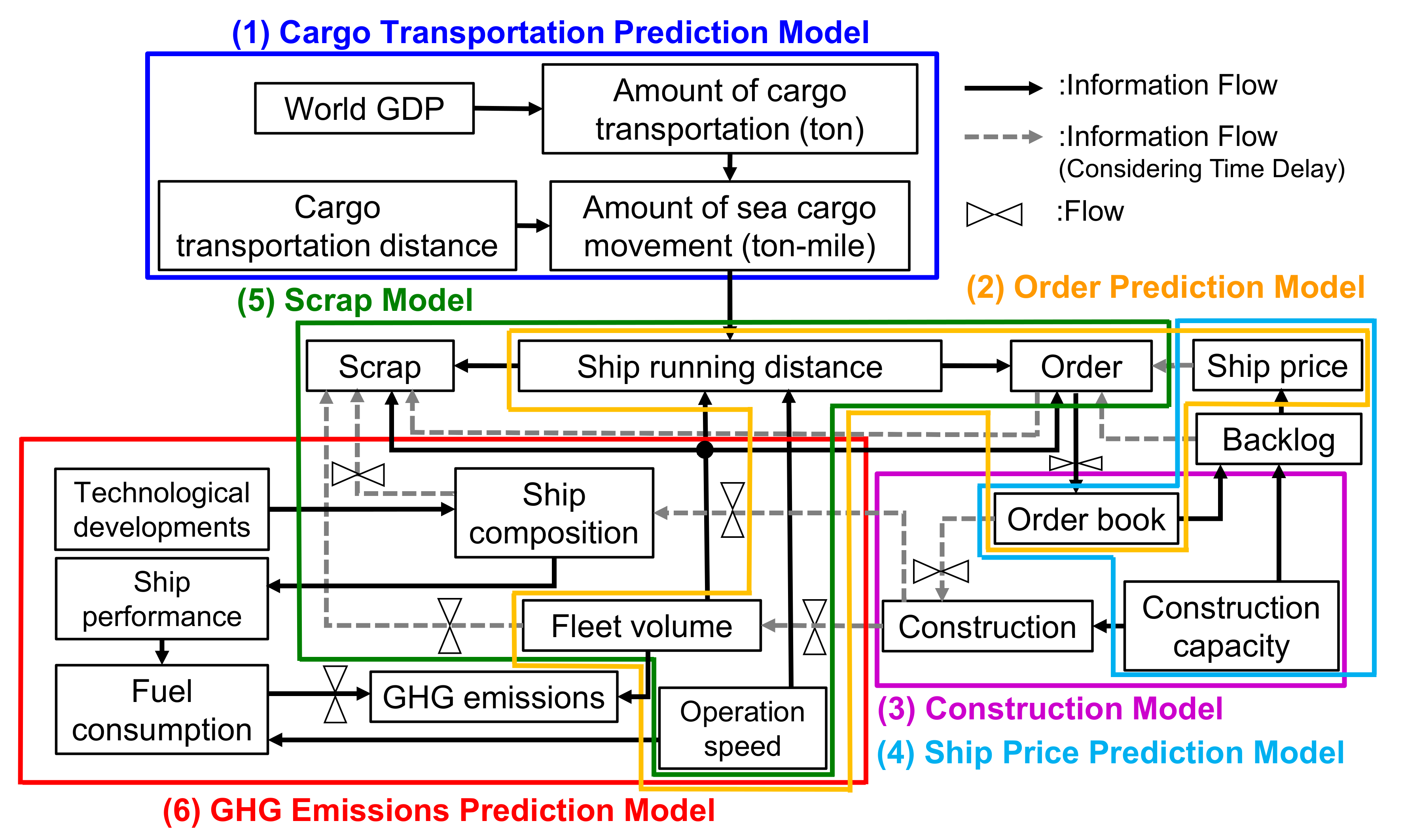
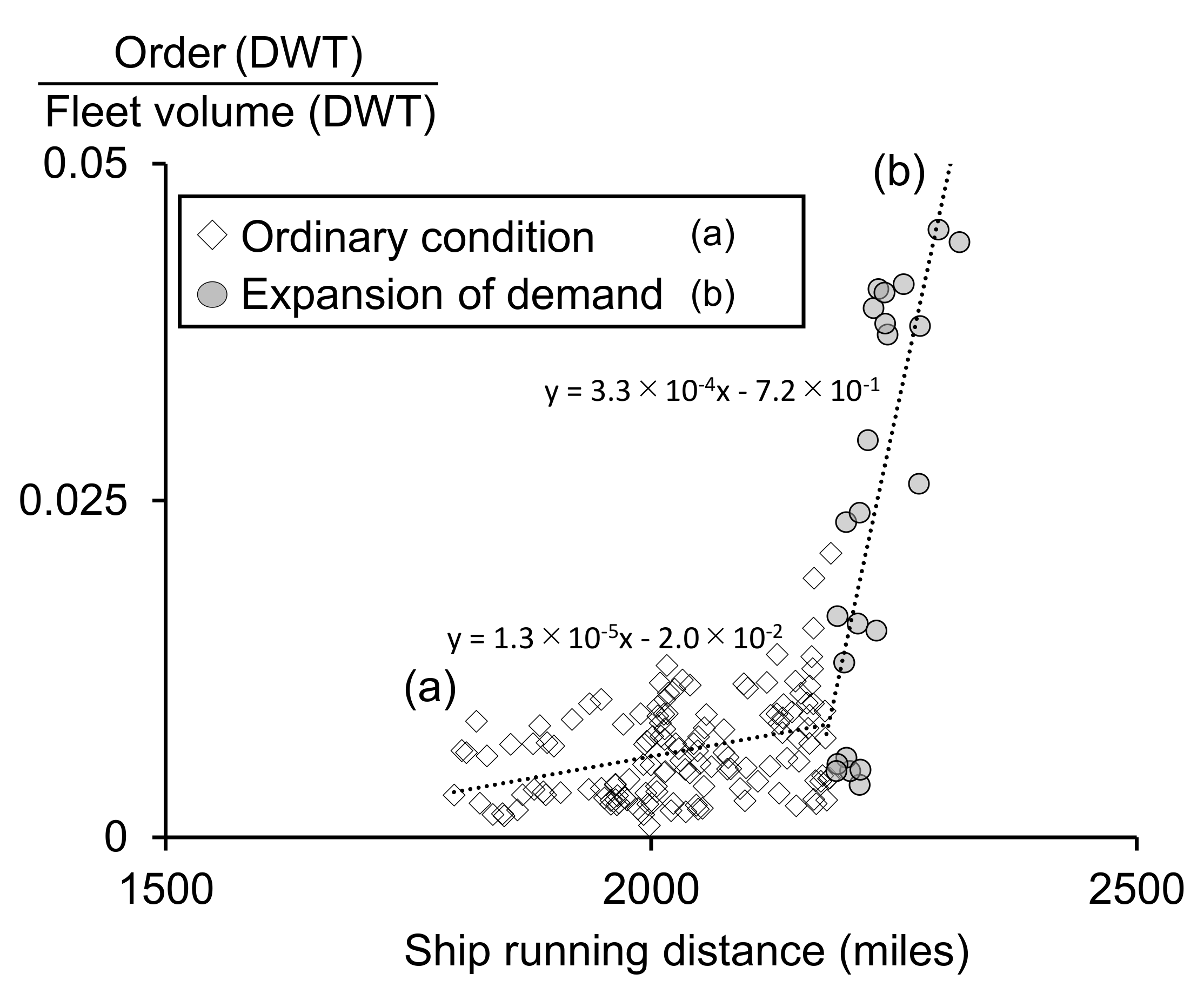
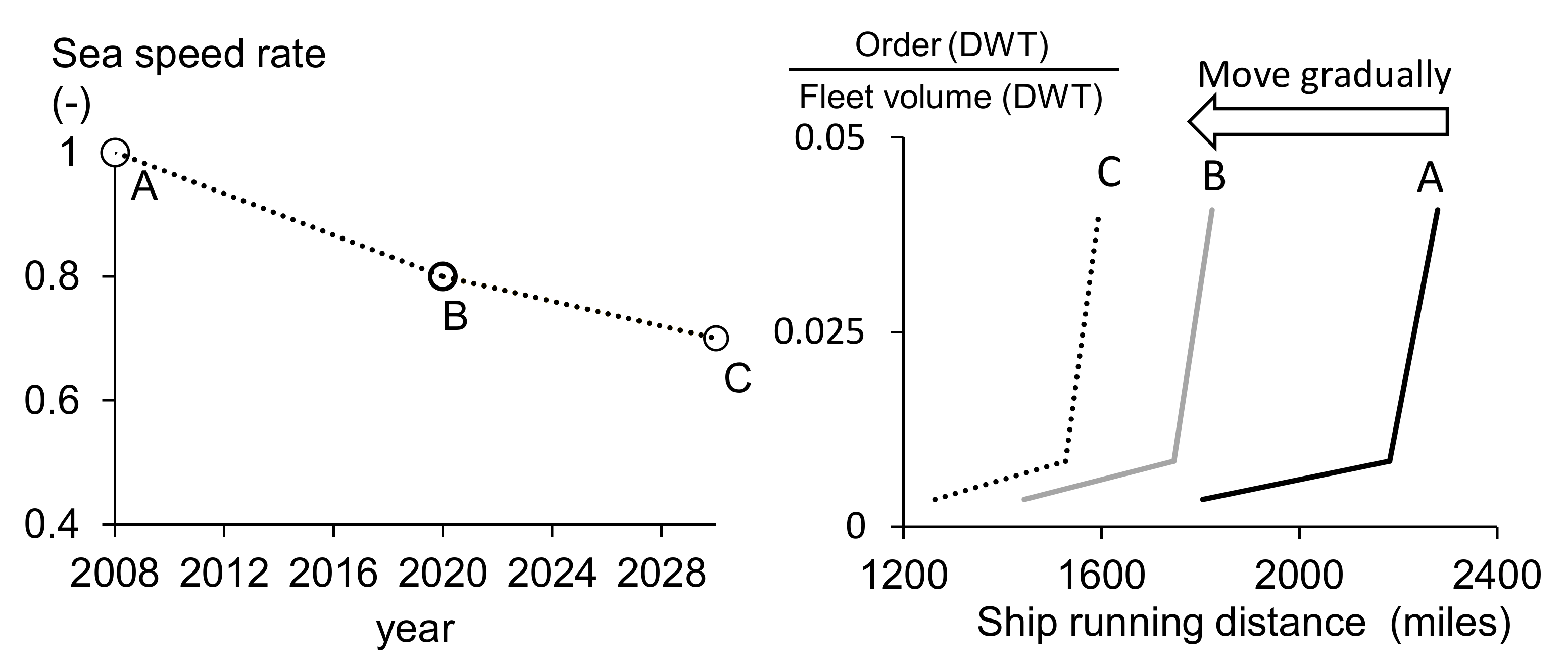
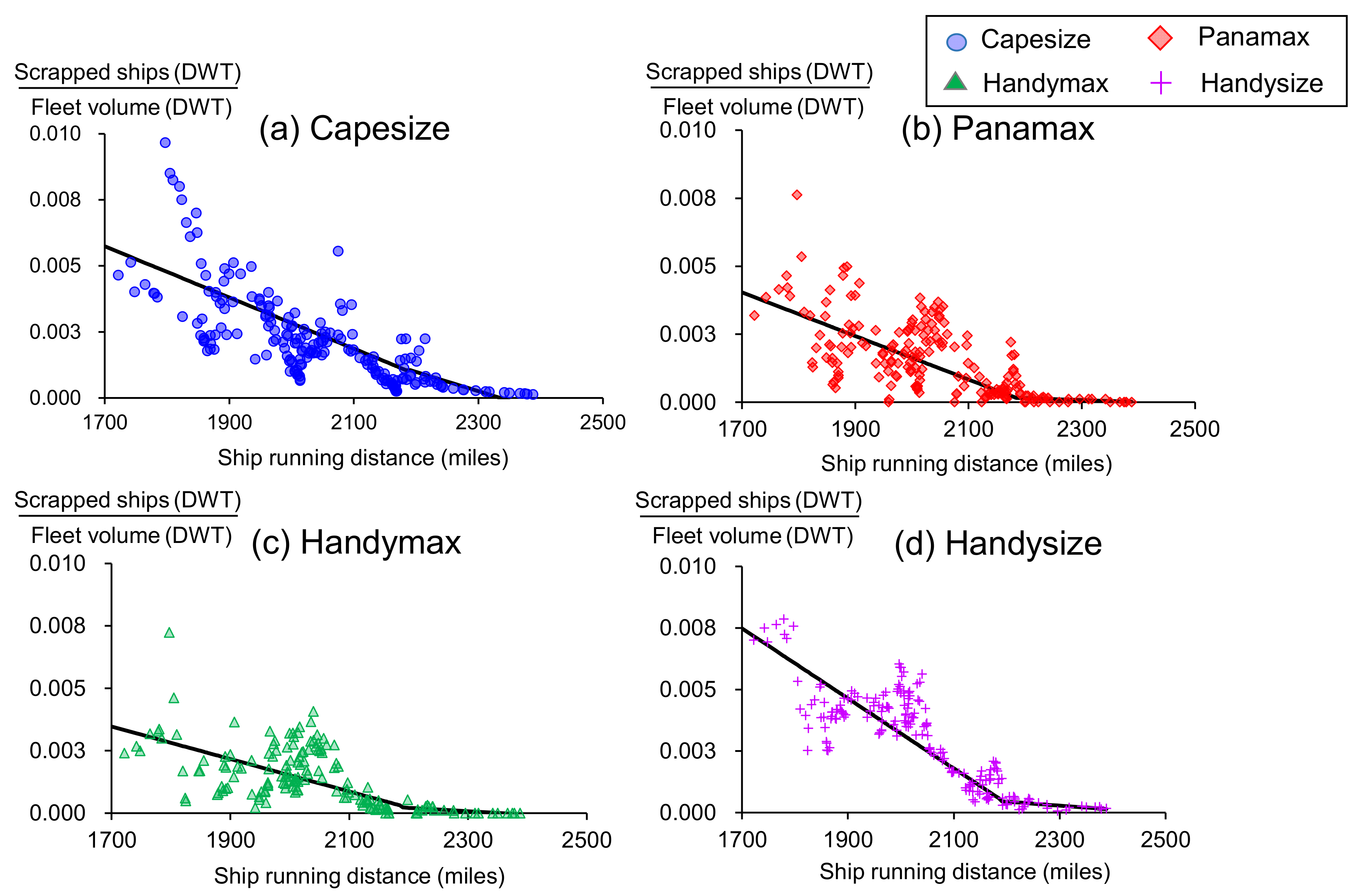
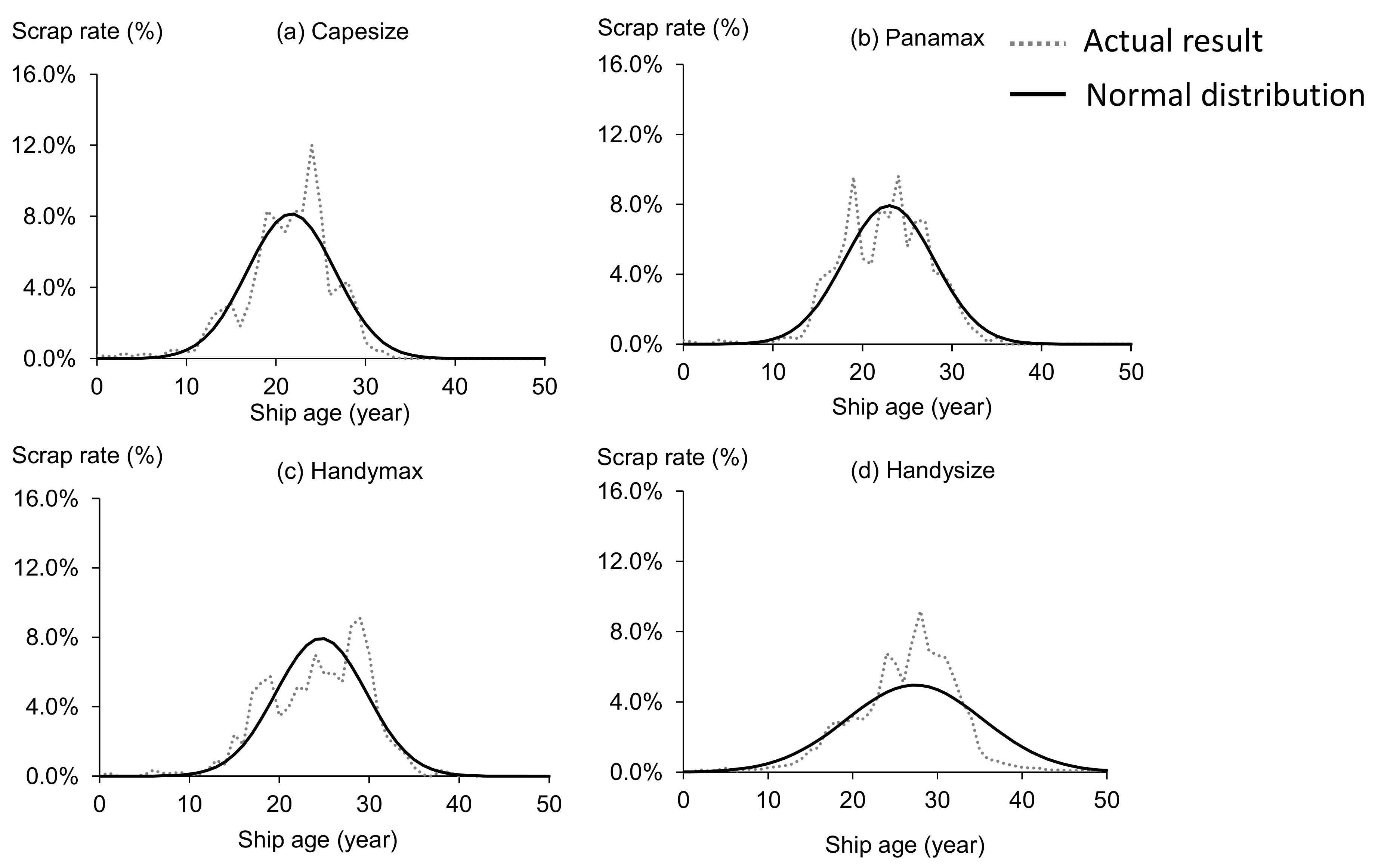
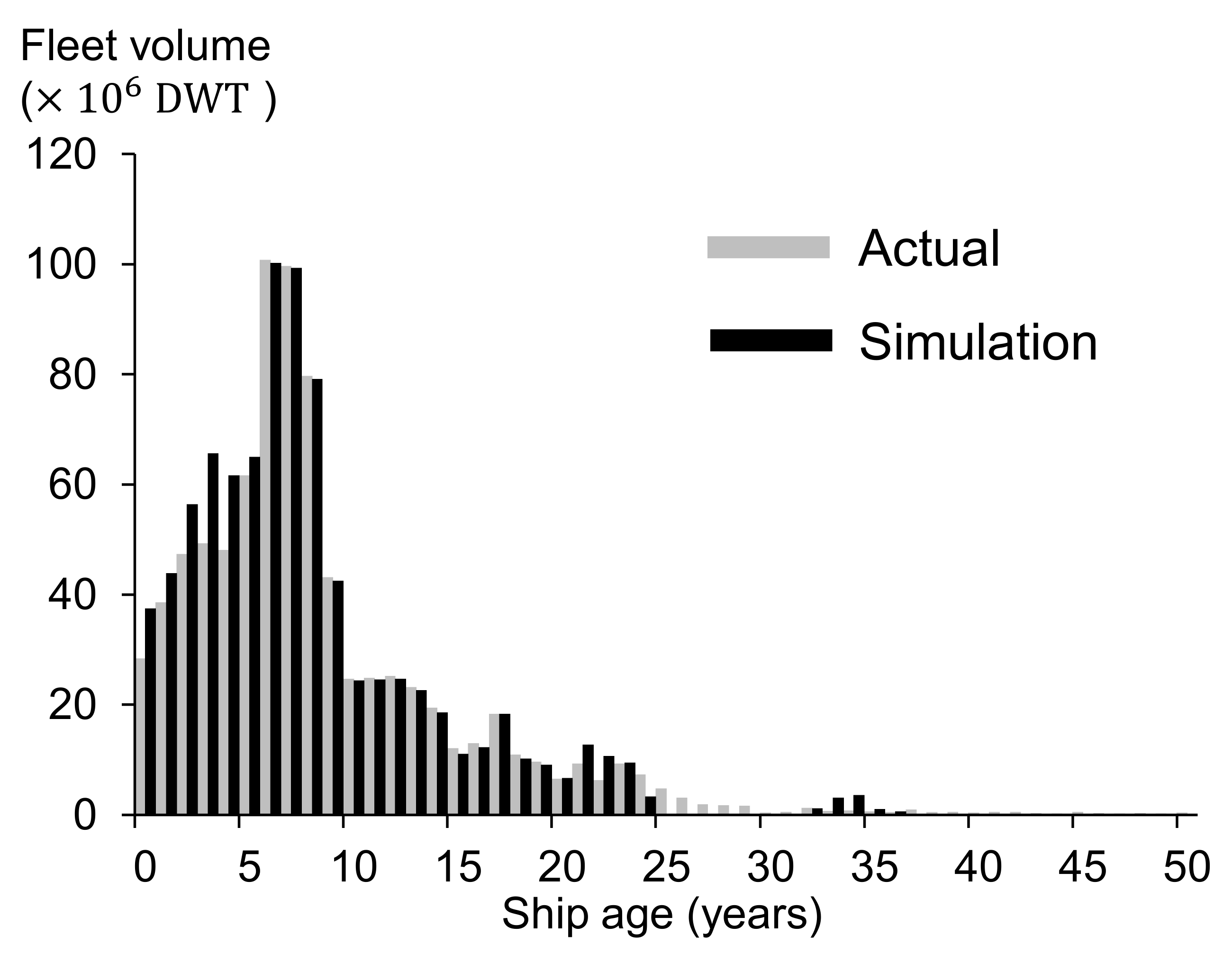
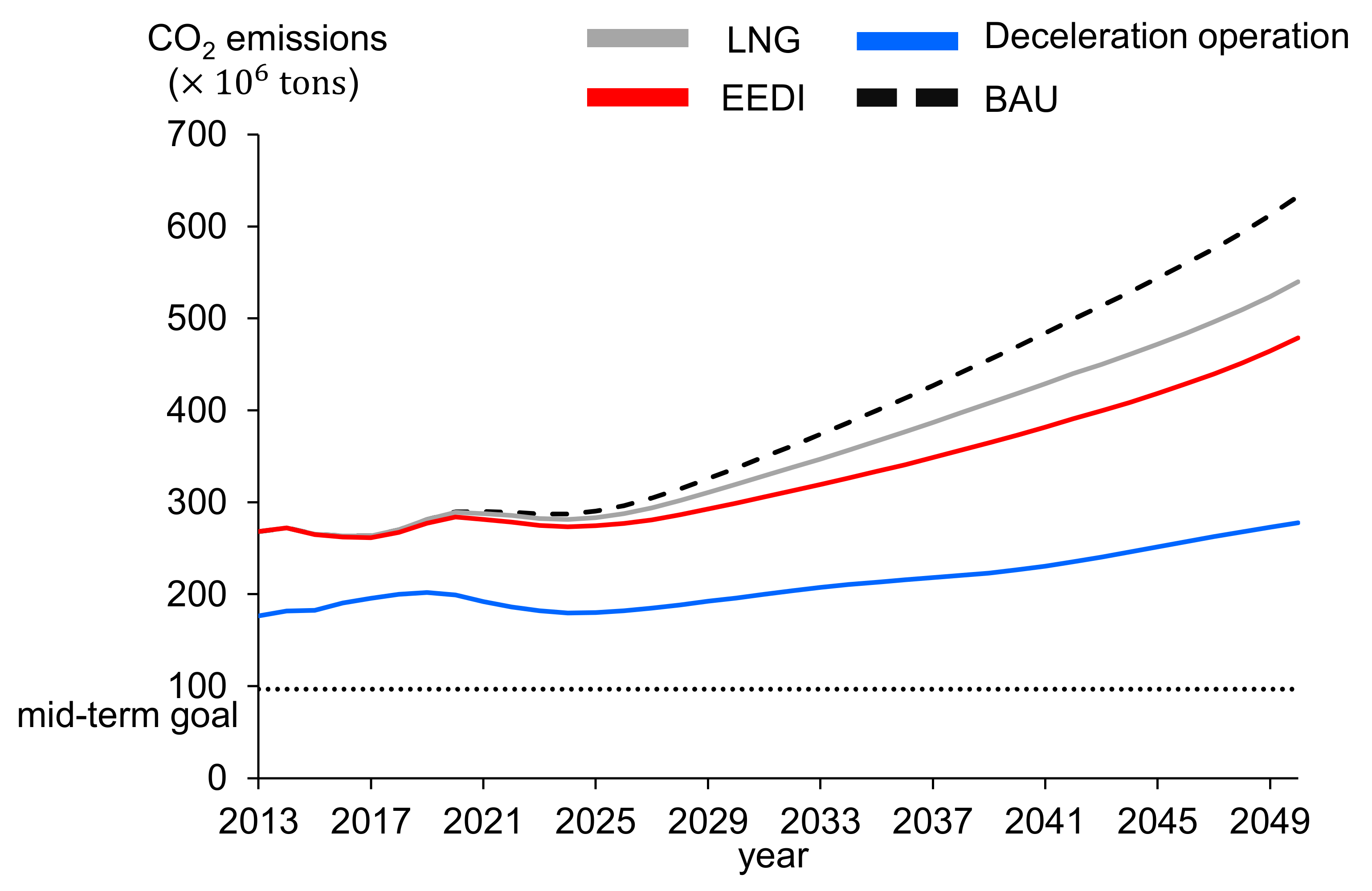

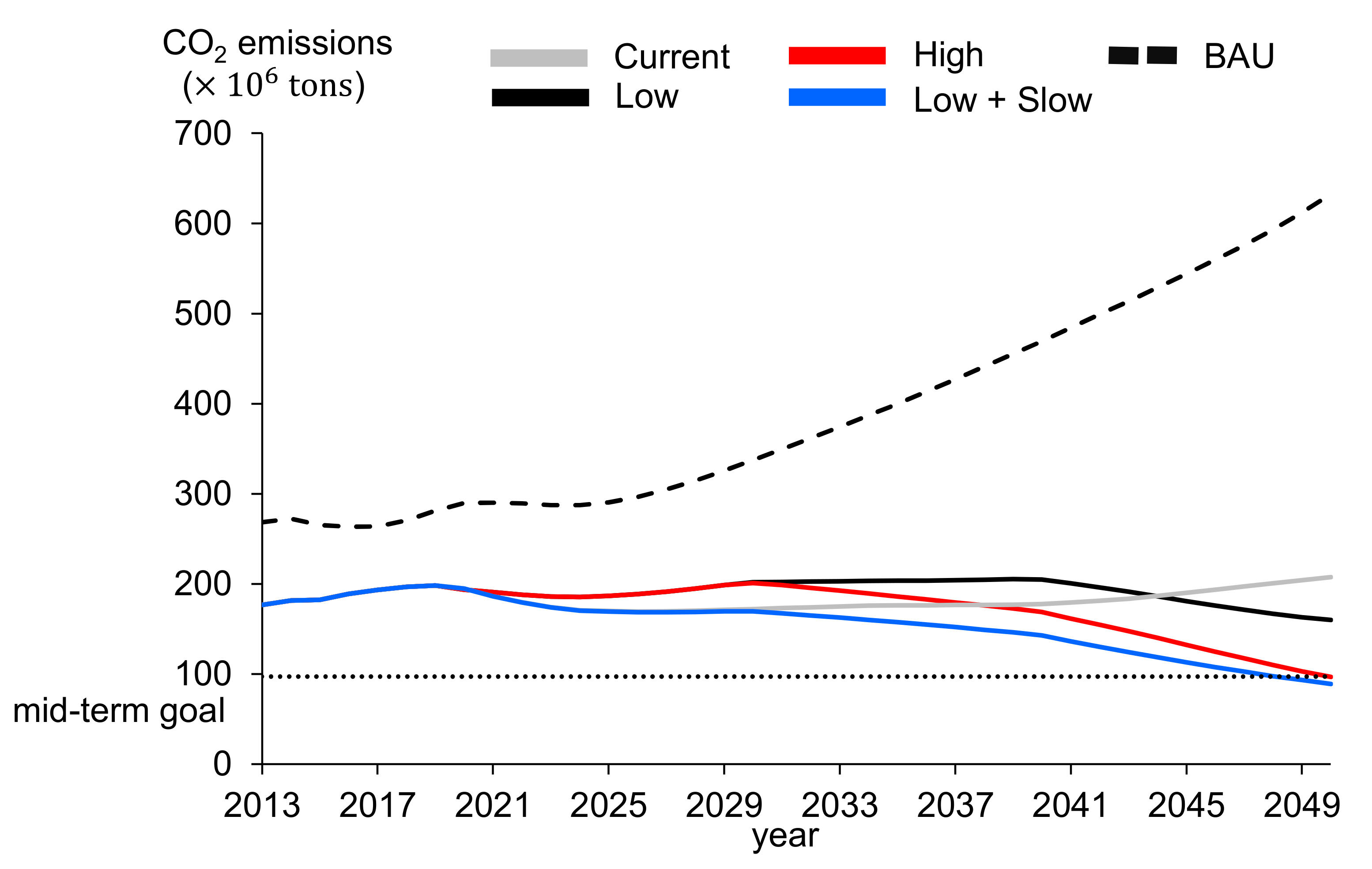
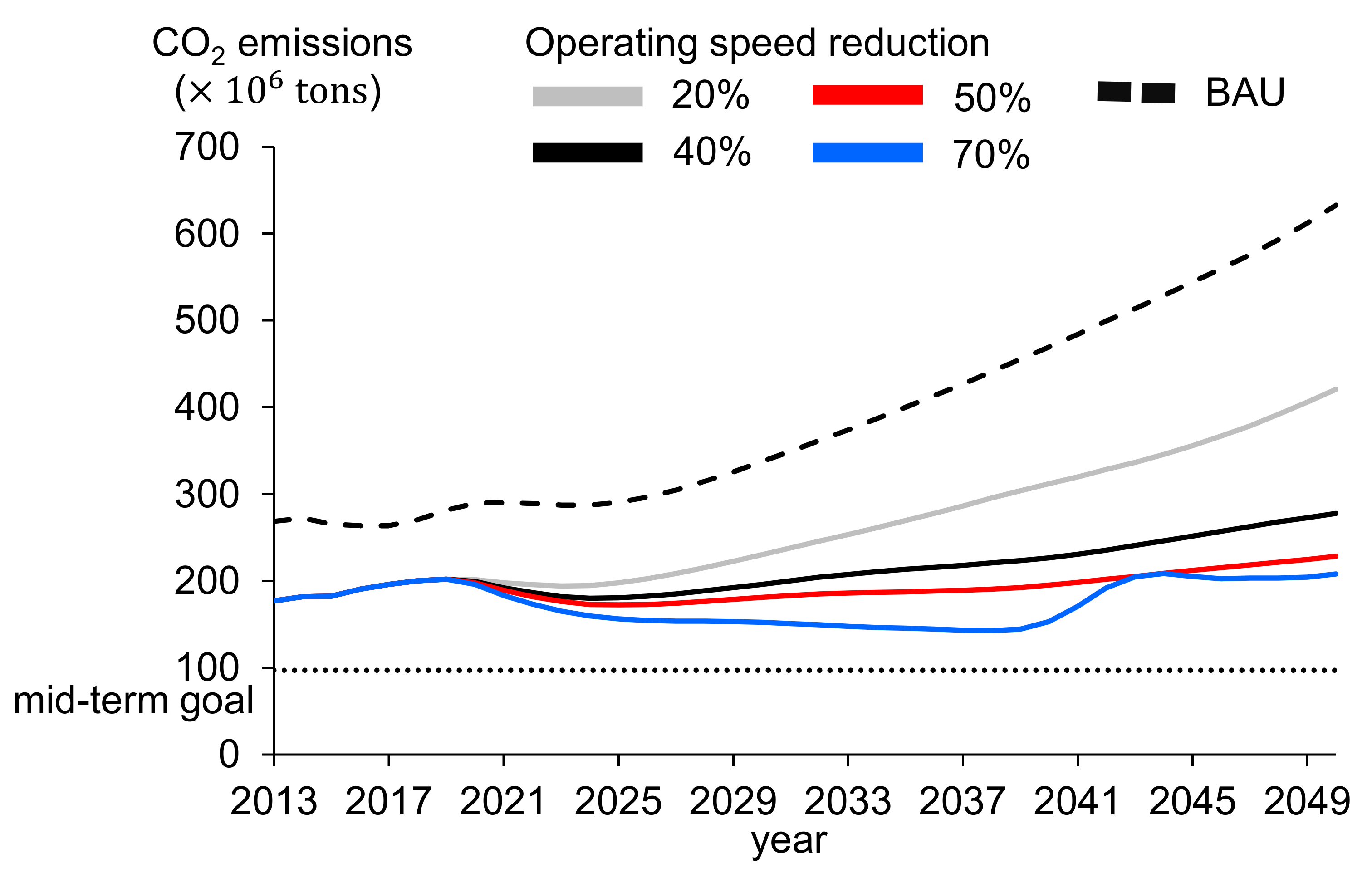
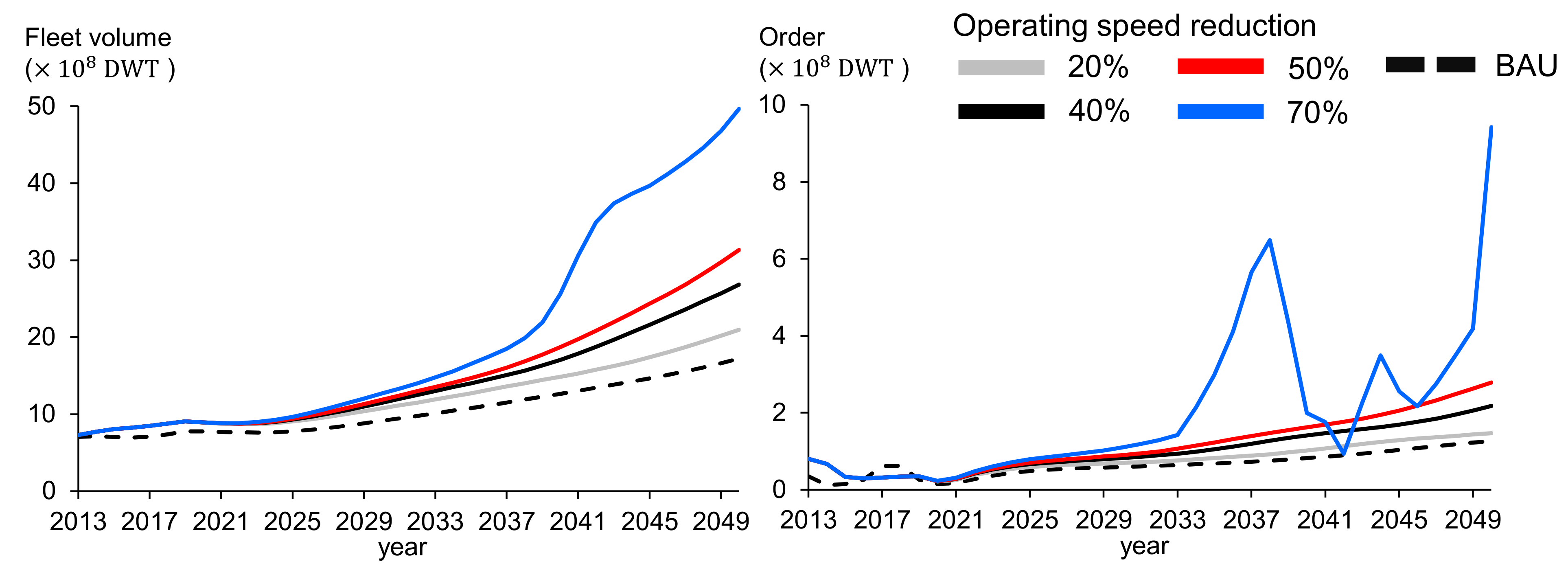
| Data Name | Source | Unit | Usage Period |
|---|---|---|---|
| Ship composition | Sea-web ships [24] | DWT | 2013–2018 |
| Main engine power | Sea-web ships [24] | kW | 2013–2018 |
| Service speed | Sea-web ships [24] | knot | 2013–2018 |
| Specific fuel consumption (SFC) | Fourth IMO GHG Study [4] | g/kWh | - |
| Fuel consumption | Fourth IMO GHG Study [4] | g | 2013–2018 |
| Average voyage time | Fourth IMO GHG Study [4] | h | 2013–2018 |
| Average DWT | Sea-web ships [24] | DWT | 2013–2018 |
| Calibration factor | Fourth IMO GHG Study [4] | - | 2013–2018 |
| CO2 emission correction coefficient | Fourth IMO GHG Study [4] | - | 2013–2018 |
| Scrap ship list | Sea-web ships [24] | DWT | Until 2018 |
| Data Name | Unit | Capesize | Panamax | Handymax | Handysize |
|---|---|---|---|---|---|
| Main engine power | kW | 17,641 | 10,248 | 8,680 | 6,290 |
| Service speed | knots | 14.5 | 14.4 | 14.4 | 13.9 |
| Fuel consumption of auxiliary | ton/month | 58.3 | 58.3 | 37.2 | 27.6 |
| Fuel consumption of boiler | ton/month | 22.1 | 26.4 | 18.2 | 11.0 |
| Average voyage time | h/month | 491 | 417 | 374 | 355 |
| Average DWT | DWT | 189,919 | 79,839 | 54,322 | 29,348 |
| Calibration factor | - | 1.10 | 1.02 | 1.05 | 0.88 |
| CO2 emissions correction coefficient | - | 1.02 | |||
| Engine Age | >15,000 kW | 15,000–5000 kW | <5000 kW |
|---|---|---|---|
| Before 1983 | 205 | 215 | 225 |
| 1984–2000 | 185 | 195 | 205 |
| After 2001 | 175 | 185 | 195 |
| Year | 2013 | 2014 | 2015 | 2016 | 2017 | 2018 |
|---|---|---|---|---|---|---|
| Fourth IMO GHG Study (×106 tons) | 177.7 | 177.3 | 184.2 | 192.0 | 198.4 | 193.4 |
| This Study (×106 tons) | 176.6 | 181.7 | 182.3 | 189.0 | 193.4 | 196.8 |
| Error (%) | −0.6 | +2.5 | −1.0 | −1.6 | −2.5 | +1.8 |
| Year | –2019 | 2020–2029 | 2030–2039 | 2040–2050 |
|---|---|---|---|---|
| Fleet scenario: LNG | ||||
| HFO (%) | 100 | 50 | 40 | 30 |
| LNG (%) | 0 | 50 | 60 | 70 |
| Year | EEDI Regulation | Reduction Relative to Baseline, Taking SFC into Account |
|---|---|---|
| After 2013 | 0% | −7.5% |
| After 2015 | 10% | 2.5% |
| After 2020 | 20% | 12.5% |
| After 2025 | 30% | 22.5% |
| Year | –2019 | 2020–2029 | 2030–2039 | 2040–2050 |
|---|---|---|---|---|
| Fleet Scenario: Low | ||||
| HFO (%) | 100 | 20 | 10 | 0 |
| LNG (%) | 0 | 80 | 60 | 30 |
| Zero-Emission Fuel (%) | 0 | 0 | 30 | 70 |
| Fleet Scenario: High | ||||
| HFO (%) | 100 | 20 | 0 | 0 |
| LNG (%) | 0 | 80 | 40 | 10 |
| Zero-Emission Fuel (%) | 0 | 0 | 60 | 90 |
| Scenario Name | Fleet Scenario | Operating Speed Deceleration Scenario | Technological Development to Achieve EEDI Regulation | LNG Fuel | Zero-Emission Ships |
|---|---|---|---|---|---|
| Current | LNG (Table 5) | 40% deceleration in 2050 (Linearly reduce) | ◯ | ◯ | N/A |
| Low | Low (Table 7) | Constant | ◯ | ◯ | ◯ |
| High | High (Table 7) | Constant | ◯ | ◯ | ◯ |
| Low + Slow | Low (Table 7) | 40% deceleration in 2050 (Linearly reduce) | ◯ | ◯ | ◯ |
Publisher’s Note: MDPI stays neutral with regard to jurisdictional claims in published maps and institutional affiliations. |
© 2021 by the authors. Licensee MDPI, Basel, Switzerland. This article is an open access article distributed under the terms and conditions of the Creative Commons Attribution (CC BY) license (http://creativecommons.org/licenses/by/4.0/).
Share and Cite
Wada, Y.; Yamamura, T.; Hamada, K.; Wanaka, S. Evaluation of GHG Emission Measures Based on Shipping and Shipbuilding Market Forecasting. Sustainability 2021, 13, 2760. https://doi.org/10.3390/su13052760
Wada Y, Yamamura T, Hamada K, Wanaka S. Evaluation of GHG Emission Measures Based on Shipping and Shipbuilding Market Forecasting. Sustainability. 2021; 13(5):2760. https://doi.org/10.3390/su13052760
Chicago/Turabian StyleWada, Yujiro, Tatsumi Yamamura, Kunihiro Hamada, and Shinnosuke Wanaka. 2021. "Evaluation of GHG Emission Measures Based on Shipping and Shipbuilding Market Forecasting" Sustainability 13, no. 5: 2760. https://doi.org/10.3390/su13052760
APA StyleWada, Y., Yamamura, T., Hamada, K., & Wanaka, S. (2021). Evaluation of GHG Emission Measures Based on Shipping and Shipbuilding Market Forecasting. Sustainability, 13(5), 2760. https://doi.org/10.3390/su13052760






